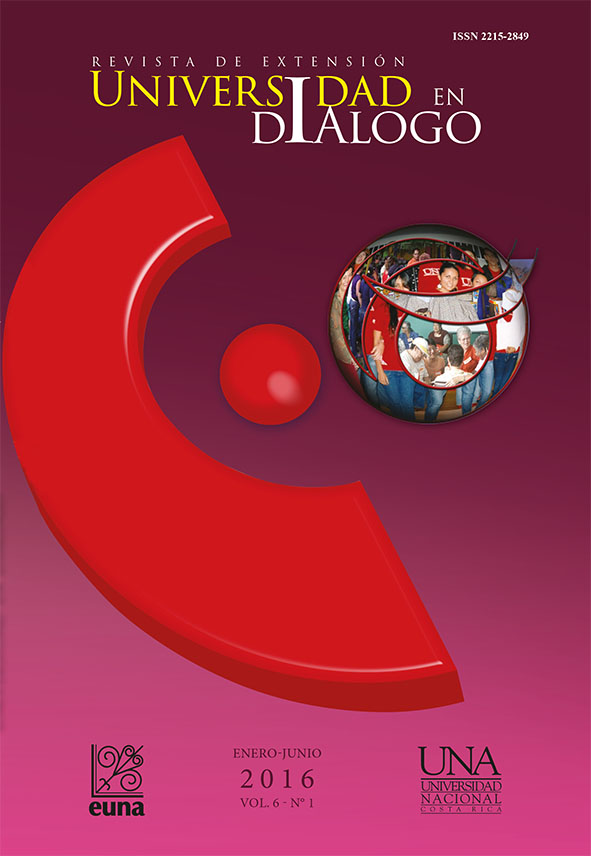Effect of a training program to improve the maximal oxygen uptake of soccer players of a team from the first division of the soccer of Costa Rica
DOI:
https://doi.org/10.15359/udre.6-1.1Keywords:
Elite soccer players, VO2 max, Yo-Yo test, aerobic training programAbstract
Purpose: To determine the effect of an aerobic training program of aerobic power on Costa Rican professional soccer players. Subjects: 24 male subjects, with a mean age of 25.7 ± 3, 4 years. Instruments: The Yo-Yo test was used in the intermittent recovery version to assess possible changes in the aerobic power of the players. Procedure: for the preseason tournament for winter 2012 and summer 2013, a pre-test was applied to assess the current state their subsequently, they were put on a seven-week aerobic program. Finally, the post-test was applied to assess the effect of the training program. Statistical analysis: Descriptive statistics were applied as well as the non-parametric techniques of the Wilcoxon and Friedman test and t-student for repeated measures using the Statistical Package for Social Sciences SPSS (17 version), the significance level used was p ≤ 0.05. Results: A statistically significant improvement of the players’ maximum oxygen consumption was recorded. Conclusion: The proposed program improved the soccer players’ maximum oxygen consumption power of the players.
References
Bangsbo, J. (1994). The Physiology of Soccer with Special Reference to Intense Intermittent Exercise. Acta Physiol. Scand. 619, 1-155.
Bangsbo, J. (1999). Yo-Yo tests. Buenos Aires, Argentina: Editorial Paidotribo.
Bagnsbo, J., Marcello, F. y Krustrup, P. (2008). The Yo-Yo intermittent recovery test. Sports Medicine, 38(1), 37-51.
Bangsbo, J., Mohr, M., & Krustrup, P. (2006). Physical and metabolic demands of training and match-play in the elite football player. Journal of Sports Sciences, 24(7), 665-674. doi:10.1080/02640410500482529
Bangsbo, J. y Krustrup, P. (2003). El test Yo-Yo de recuperación intermitente: Respuesta fisiológica, confiabilidad y validación. Recuperado de http://www.futbolrendimiento.com.ar/Download/test%20yoyo.pdf
Bosco, C. (1994). Aspectos fisiológicos de la preparación física del futbolista. Barcelona, España: Editorial Paidotribo.
Campos, M. (2012). Consideraciones para la mejora de la resistencia en el fútbol. Apuntes Educación Física y Deportes, 110(4), 45-51.
Di Salvo, V., Baron, R., Tschan, H., Calderon Montero, F. J., Bachl, N., & Pigozzi, F. (2007). Performance characteristics according to playing position in elite soccer. International Journal of Sports Medicine, 28(3), 222-227. doi:10.1055/s-2006-924294
Hoff, J. (2005). Training and testing physical capacities for elite soccer players. Journal of Sports Sciences, 23(6), 573-582. doi:10.1080/02640410400021252
Hoff, J., & Helgerud, J. (2004). Endurance and strength training for soccer players: Physiological considerations. Sports Medicine, 34(3), 165-180. doi:10.2165/00007256-200434030-00003
Molnar, G. (2000). Análisis sistemático del entrenamiento del futbolista. Recuperado de http://www.chasque.apc.org/gamolnar/futbol.0/.html.
Reilly, T. (1996). Aspectos fisiológicos del fútbol. Actualización en Ciencias del Deporte, 13(4). Recuperado de: http://g-se.com/es/journals/publice-standard/articulos/aspectos-fisiologicos-del-futbol-165
Slenklewicz-Dianzenza, E., Rusin, M. & Stupnicki, R. (mayo-junio, 2009). Anaerobic resistance of soccer players. Fitness performance, 8(3), 199-203.
Svensson, M., & Drust, B. (2005). Testing soccer players. Journal of Sports Science, 23(6), 601-618.
Urzua, R., Von Oetinger, A., Cancino, J. (2009). Potencia aeróbica máxima, fuerza explosiva del miembro inferior y peak de torque isocinético en futbolistas chilenos profesionales y universitarios. Revista CRONOS, 14(8), 49-52.
Ziogas, G. G., Patras, K. N., Stergiou, N., & Georgoulis, A. D. (2011). Velocity at lactate threshold and running economy must also be considered along with maximal oxygen uptake when testing elite soccer players during preseason. Journal of Strength and Conditioning Research, 25(2), 414-419. doi:10.1519/ JSC.0b013e3181bac3b9
Downloads
Published
How to Cite
Issue
Section
License

La Revista y cada uno de los artículos que se publican están licenciados por Creative Commons Atribución No comercial Sin derivadas 4.0 Internacional.



